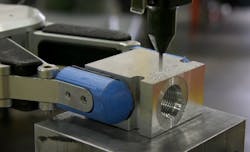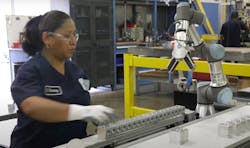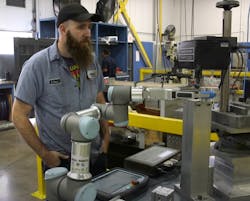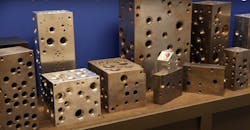The implementation of a collaborative robot with a flexible gripper at Tomenson Machine Works in West Chicago, Ill., is a prime example of how small to mid-sized manufacturers are embracing some of the newest automation advances and reaping their cost saving benefits.
Kristian Hulgard, general manager – Americas at OnRobot, said Tomenson is a typical customer for OnRobot, i.e., a small company that had never really automated before. “But once they saw how cobots were installed and work, they quickly took steps to install a robot with a flexible gripper to automate the process of numbering metal manifold blocks,” he said.
“The reason we chose pin stamping for our first application with robotics is because we saw it as basically the easiest and the most repetitive task on the production floor,” said Roake. “We like the OnRobot gripper for this application because we have many different part sizes and we knew that the RG6 could handle our biggest parts and our smallest parts going into the pin stamp."
According to OnRobot, the RG6 can handle parts from ½-inch to 4 inches in size.
Roake explained that Tomenson programs the RG6 using the same lines of code for each part. “We start at the largest size the gripper can handle and then close it until it senses that it's closed around the part,” he said. “Programming the pin stamp is much harder than programming the gripper,” he added.
Manufacturing small blocks for hydraulic manifolds produced low margins for Tomenson before the implementation of the cobot and gripper. “Now when we see a small block order, we're not afraid to quote it because we know that the handling of thousands and thousands of these will be done by the robot,” said Roake. “This allows us to focus on the more complex and longer cycle blocks that need more attention.”
Since the introduction of the cobot and gripper into the pin stamping application, Zach Roake, quality and post-production manager at Tomenson, said the company has seen
“about a 40% reduction in misloads” caused by engraving the wrong side of the block or engraving in the wrong direction. “We’re calculating that we can now run our gripper on first and second shift to get a return on investment in roughly 6 to 7 months.”
Because the cobot arm and gripper can run unattended for around 45 minutes, Tomenson can use the same person to run the line saw and the cobot, rather than needing two people for these operations. Roake said that the company’s previous pin stamp operator was “moved to a different department where she was able to do more meaningful work.”
Leaders relevant to this article:






